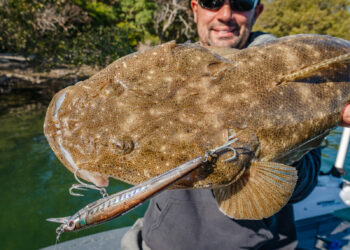THE Stripey (Lutjanus carponotatus), also known as Spanish flag or gold-stripe sea perch, is one of the most common members of the family Lutjanidae found on our northern coral reefs.
This species has a typical lutjanid body shape, but is easily distinguished from most other tropical snappers by their distinctive colouration. Lacking the black spot on the side like the closely related moses perch, stripeys have silvery sides decorated by six to eight golden/brown stripes running horizontally along each flank. The paired fins are yellow while the tail and dorsal fins can be yellow to a strong light orange in some larger specimens, while the eye is relatively large.
Stripeys are most commonly encountered around shallow inshore reefs throughout the central tropical Indo-Pacific region, from India to Vietnam and south to Australia. In Australia, stripeys can be encountered around rocky or coral reefs throughout our northern coastline, from near Geralton in the west throughout the top end to as far south as the Sunshine Coast near Brisbane. They are, however, most numerous over the reef flats and edges of the Great Barrier Reef where they thrive, prowling around near coral outcrops and overhangs, sometimes in schools of upwards of 20 to 30 fish.
These attractive little fish are one of the smaller lutjanids, growing only to around 40 cm long and a bit over 1 kg. Despite their relatively small size, like their larger lutjanid cousins stripeys are active predators which use ambush tactics to prey mostly on smaller fishes and crustaceans. However, I’ve personally seen larger stripeys regurgitate whole juvenile sea turtles, so they are certainly high on the aggressiveness scale on a pound for pound basis. To assist with their predatory activities, they possess the usual lutjanid array of sharp needle-like canine teeth at the front of the mouth, which are adapted to seize and hold their prey.
In the past, stripeys were not considered to be much of a target species for those fishing on the Great Barrier Reef. They were usually used as bait rather than being eaten, due to their small size. However, they are a plucky little light tackle sportfish, being avid lure takers that can provide much fun on small minnows, jigs and plastics.
Like other lutjanids, stripeys do not change sex during their lives, and recent research has found they can live for 20 to 30 years, ie: similar ages to larger lutjanids like mangrove jacks and red emperors. This means stripeys are a relatively slow growing species, even though their initial growth rate is typical of other lutjanids in being quite fast. Indeed, they appear to reach around 15 cm fork length in their first year, and 20 cm in their second year, but growth slows markedly after that once the fish reach maturity, which occurs between 20 and 25 cm long.
Studies of mature female stripeys have found that the fecundity (number of eggs produced) increases markedly with the size of the fish. Smaller females around 20 cm long produced as few as 7000 eggs, while a 30 cm female could produce upwards of 100 times more eggs at any one time (over 700,000). The diameter of the eggs produced by the larger female stripeys was also larger on average, suggesting that the energy reserves (and thus survival chances) of larvae spawned from larger stripeys would be increased.
Based on this data, and given the slow growth rate of this species after maturity, the researchers hypothesised that stripeys were likely to be one species of fish for which recruitment might benefit from establishment of no take zones within marine protected areas on the Great Barrier Reef.
Even so, given the majority of stripeys on coral reefs live on shallow reef flats less than 2 metres deep and the survival rates of stripeys caught on sportfishing gear from shallow water has been shown to be 98-100 per cent, there appears to be an opportunity to encourage catch and release fishing for stripeys over shallow reef flats, as a potential alternative to total fishing bans. Thus the “no take” zone could protect recruitment with potential ecological benefits, while “no take” catch and release fishing could still provide substantial socioeconomic benefits.
If only coral reef management in Australia could be flexible enough to accommodate such a scenario…





















